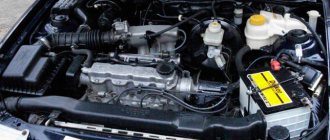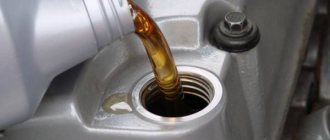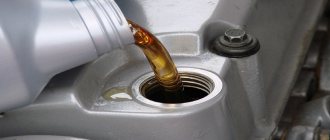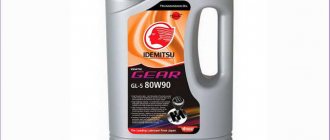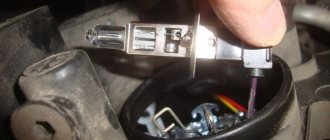| Place | Name | Characteristics in the rating |
| The best semi-synthetic oil |
| 1 | MOTUL 6100 Synergy+ 10W40 | Reliable engine protection |
| 2 | MOBIL Super 2000 X1 10W-40 | Optimal combination of price and quality |
| 3 | Eni/Agip i-Sint 10W-40 | Best Features |
| 4 | LIQUI MOLY Special Tec V 0W-30 | Highest quality |
| 5 | Ravenol TSi SAE 10W-40 | Oil recommended by the manufacturer |
| Best synthetic oil |
| 1 | VOLKSWAGEN Special Plus 5W-40 | Original synthetics |
| 2 | SHELL Helix Ultra 5W-40 | A profitable alternative |
| 3 | VOLKSWAGEN LongLife III 5W-30 | The best choice |
| 4 | Motul Specific 504 00 507 00 5W30 | Buyers' choice |
| 5 | MOBIL Super 3000 XE 5W-30 | Best price |
One of the most affordable cars on the Russian market is the VW Polo sedan. This European representative successfully competes with Asian cars (Kia Rio and Hyundai Solaris), as well as with the products of the domestic AvtoVAZ. Experts include a stylish design and a powerful, unpretentious engine as the strengths of the sedan. To ensure the durability of the power unit, the car owner should carefully select engine oil. Modern engines have minimal clearances and high power due to a number of additional systems and units. Therefore, the technical fluid must have good penetrating ability, excellent lubricating properties and excellent cleaning ability. What motor oils can cope with this set of tasks?
- First of all, original oil is capable of ensuring long-term operation of Volkswagen Polo sedan engines. It is poured on the factory conveyor; it is used by car services that service warranty vehicles. The only drawback of this material is the high price. And it’s unlikely that you’ll be able to buy such a product in the outback.
- Many motor oil manufacturers have received approval from VW for their products. This material can be used without any hassle when servicing both new and significantly older machines.
- Many motorists have extensive experience using motor oils. Trying to save money, they successfully tested semi-synthetic fluids. But not all of them are able to complete the assigned tasks.
Our review includes the best motor oils for Volkswagen Polo. When compiling the rating, experts took into account the following criteria:
- material compliance with VW specifications and tolerances;
- technical parameters of the oil;
- price range;
- expert opinion;
- reviews from Volkswagen Polo owners.
What kind of oil to pour into the Volkswagen Polo engine: oil selection and replacement
Regular replacement of engine oil and correct selection of lubricant directly affect engine life. For this reason, Volkswagen Polo owners need to know what kind of oil to pour into the Volkswagen Polo engine, when to change the oil, and also how to change the oil yourself if necessary.
From official data:
- The oil for Volkswagen Polo needs to be changed every 15 thousand km. mileage or once every 12 months (whichever comes first);
- The Volkswagen plant recommends filling the engine with lubricant with a viscosity index of 5W-40, corresponding to the VW 504 00 or VW 502 00 standard.
At the same time, experts note that in some cases the service interval must be adjusted, and motor oils from other manufacturers can also be used for replacement. Read more in our article.
When to change the oil in a Volkswagen Polo engine
Officially, an oil change should be performed every 15 thousand km. or once a year. Moreover, such intervals are more suitable for gentle operating conditions. If conditions are difficult, then replacement intervals need to be shortened.
Severe operating conditions are considered to be:
- “ragged” driving pace in the city;
- constant acceleration and stopping;
- driving at low speeds;
- easy in traffic jams;
- transportation of goods, towing a trailer, etc.
What kind of oil to pour into Polo: sedan and hatchback
The recommended oil is the standard lubricant:
- VW 504 00;
- VW 502 00.
The first type is more suitable for engines that run on high quality fuel.
In fact, this is an oil for Europe. For CIS countries, it is better to select the second type of oil. If topping is necessary, ACEA A3/B4 or API SN/SM fluids can be used. Moreover, more than 500 ml. should not be added.
As for viscosity, at the factory Volkswagen Polo engines are filled with 5W-40 oil (original VAG Special Plus 5W-40 oil). In this case, you can select analogues from other manufacturers.
In practice, visiting specialized forums helps determine what kind of oil is poured into Volkswagen Polo by the owners of these cars. This way you can choose the best option in terms of quality and price. It is also important that the lubricant is original, since there are many fakes of well-known brands on the market.
Checking the oil level
Taking into account the fact that even fully serviceable Volkswagen engines can consume oil, the oil level in the engine must be checked every 500 km (for new engines during “break-in”) or 1000 km. mileage
To check the oil level, you need to remove the dipstick while the engine is cool. The level at o is the maximum; topping up is not necessary. Level “B” is the middle (you can add it to level “A”). Level “C” indicates the level is decreasing, which means topping up is necessary.
How much oil to pour into the engine
When selecting oil for a Volkswagen Polo sedan or hatchback, it is also necessary to take into account the total amount of lubricant in the engine crankcase.
In this case, the total amount of lubricating fluid depends on the type of engine installed on the car.
Do-it-yourself oil change
Having prepared the oil for the Polo sedan or hatchback in the required volume, at the same time you will need to purchase a new oil filter suitable for the engine.
You also need to have tools on hand to remove the power unit protection (if equipped), unscrew the drain plug in the engine crankcase, etc.
In general, you will need:
- wrenches 13 and 18 mm;
- torque wrench;
- oil filter puller (cup wrench 74 or 80 mm);
- screwdriver/TORX key;
- container for draining “working off”;
- funnel for filling the engine with fresh oil;
To change the oil, you must first warm up the engine by driving 10-15 km, then drive the car into a pit or lift it on a lift. Next, you need to remove the standard engine sump protection (plastic) or non-standard steel one. The next step is to clean the area around the oil filler neck, as well as the area around the drain plug, of dirt with a clean rag. This completes the preparatory stage.
The actual oil change on the Polo is carried out as follows:
- unscrew the filler cap on the engine;
- Unscrew the oil drain plug with a key 18 and place a container for draining;
- after the oil stops flowing (on average, after 15 minutes), the container can be removed;
- Using film, cover the belts and assemblies in the engine compartment to prevent oil from entering;
- Unscrew the old oil filter and wipe its installation location;
- screw in a new filter element, tightening it to a torque of 20 Nm;
- tighten the plug in the pan, replacing the sealing gasket (if any);
- then pour 2.5-3 liters of oil (depending on the type of engine) in portions through the funnel in the filler neck, since the neck is narrow.
- after filling the main part of the lubricant, check the level and adjust if necessary;
- start the engine, after which the oil pressure light should go out after 2-3 seconds;
- Turn off the engine and check the engine oil level again after 3-5 minutes, as some of the lubricant may leak into the oil filter housing.
Recommendations
- If you need to change the oil, you can use the original VAG product or analogues for Volkswagen Polo. When switching from one type and manufacturer of oil to another, it is necessary to flush the engine to avoid mixing residues of old and new oil.
- To flush the engine, you can use both conventional detergent additives and full-volume flushing oils. For a number of reasons, the second option is more preferable, but in practice it will require more time and expense.
- Before installing the oil filter, not all Polo engines require pouring a small amount of oil into the filter housing. This is due to the location of the filter, from which oil simply flows out during installation. For this reason, you need to be prepared for the fact that after a test run of the engine, the oil level will drop, since some of it will end up in the oil filter housing. Taking into account this feature, the lubrication level must be checked and adjusted.
Article rating:
Rating of the best motor oils for Volkswagen Polo - what lubricant to fill and how often to change, list of brands, cost in stores Link to main publication
Related publications
Masks for problem skin: options for different types
Practical subtleties
The selection of oil begins with determining the required viscosity, which is prescribed on absolutely all product containers.
Before choosing an oil, you need to understand the nomenclature. The designation on the packaging includes letters and numbers, for example - 5w/40 . The first letter and number is the cold viscosity. They show at what negative temperature the oil will lose its properties:
- -35º – 0w;
- -30º – 5w;
- -25º – 10w;
- -20º – 15w;
- -15º – 20w.
The second number indicates the consistency when heated. The higher the number, the better the viscosity . These designations are suitable for oil marked SAE , it is common and is poured into most cars.
The Volkswagen Polo sedan operating book indicates the recommended oil specification tolerance. The second important criterion is oil tolerance. It is designated by an alphanumeric article and is assigned to brands after studying the composition. Using it, you can select a product for a specific model, taking into account the operating characteristics of the motor.
[custom_ads_shortcode2]
Lubricant volume
The amount of oil required for full operation of the power unit depends on the specific modification of the engine:
- 2,105 l. With. – 3.8 l;
- 2 60/70 l. With. – 2.8 l;
- 4 85 l. With. – 3.2 l;
- 4,125 l. With. – 4 l;
- 6 85/90 l. With. – 3.6 l;
- 6,105 l. With. – 3.8 l;
- 6 110 l. With. – 4.2 l.
Before pouring oil into the Volkswagen Polo engine, it is necessary to completely drain the used fluid from the engine. Only a small amount of old material remains in the crankcase - about 200-300 ml. The amount of compound poured must exactly correspond to the factory requirements. Underfilling and overfilling of oil can negatively affect the operation of the power unit, since this changes the pressure in the system. After pouring the required amount of motor oil into the engine, you should check the level with an indicator dipstick. The oil mark on it should be between the minimum and maximum marks.
What oil do car enthusiasts use for 1.6?
To replace, you will need 3.8 liters of oil; you can buy a standard packaged volume for refilling. If a major overhaul is carried out and the pan is completely unscrewed, the entire bottle will fit into the engine.
These brands are chosen by car enthusiasts; the rating is based on reviews and practical tests. Castrol oil is filled from the factory; many brands are recommended by the manufacturer.
All product options are suitable for article number 502.00, you can try to find tolerance 504.00.
Tolerance 504.00
Motor oil that meets tolerance 504.00 has higher flushing properties, is less susceptible to oxidation and more effectively prevents the formation of various deposits. The manufacturer recommends using oil with a 504.00 approval for Russia, and here’s why:
- does not lose its properties longer during long periods of downtime in traffic jams;
- does not oxidize over time and forms less deposits;
- does not clog oil channels and is easily removed when washed.
The interval with this tolerance is up to 15,000 km . This was done to please nature, but to the detriment of engine life (editor's opinion). We have already written in detail about resetting the service interval.
[custom_ads_shortcode1]
Transmission oil for Polo liftback box
During the operation of transmissions, lubricating fluids accumulate wear products and, as a result, both bearings and bushings, and the gears themselves, in turn, are subject to intense wear. In addition, due to serious periodic loads, the boxes are subject to temperature changes, so gaps appear at the joints of the body parts, which is fraught with the occurrence of oil leaks.
On the one hand, severe contamination, and on the other, a decrease in the volume of lubricant can lead to complete failure of the gearbox.
Based on the practice of using transmission lubricants, as well as in accordance with the factory recommendations for VW Polo with a manual gearbox, the most optimal is hypoid type oil with a viscosity of 75W90. In other words, in garage terminology, this lubricant is an all-season semi-synthetic, universal application with a sufficient set of both protective and detergent additives for long-term operation.
As for lubricating fluids in an automatic transmission, firstly, they are labeled as ATF (for manual transmissions, the transmission brand is MTF) with a viscosity in winter ranging from 75W to 90W, and in summer from 80 to 250 units viscosity
Regarding the use of all-season lubricant for the Polo automatic transmission, this is the previously mentioned hypoid lubricant 75W90.
To accurately determine the required oil for a particular Volkswagen Polo transmission, there is a special ETKA program, where using the car’s VIN code you can select the appropriate lubricant from their extensive list in the catalog.
How to choose engine oil for a Volkswagen Polo car
Each car requires attention, care and the correct selection of elements that require replacement, including engine oil. Everyone knows that almost all engines of the Volkswagen model range are quite resistant to various operating conditions and at the same time quite durable, Polo is no exception. But the service life of the power unit directly depends on the lubricant used in the engine. The Polo model was presented to customers in several versions, namely in a hatchback and sedan body. There are also a number of engines that are installed on the Polo, these are 1.2, 1.4, 1.6-liter gasoline and 1.2 and 1.6-liter diesel. On the Polo hatchback you can find all these power units, while the sedan has only a 1.6-liter petrol engine.
Use life of motor oils
Due to the fact that we have two types of engines, we will consider two options for choosing motor lubricants: separately for diesel and gasoline. For diesel power units, it is recommended to change the oil every 70 - 100 thousand kilometers, for gasoline - every 15 - 20 thousand kilometers, depending on the load. Accordingly, the greater the load on the engine, the more often the oil should be changed.
Choosing a lubricant for a specific motor
The manufacturer uses original VAG Special Plus motor lubricant, regardless of what fuel the car runs on. The manufacturer recommends the same for topping up. Ideally, if you are concerned about the life of your car's engine, it is recommended to use an original product. But if you can’t afford the original oil or, out of other convictions, you decide to find an analogue, then when choosing a worthy replacement you should pay attention to several points.
Firstly, the temperature conditions at which the car will be used. If in your place of residence the temperature in winter does not fall below -30 degrees Celsius, and in summer the temperature does not rise above 35, then you can safely choose a lubricant with a viscosity of 5W-40. It is important to take temperature conditions into account so that there are no additional problems with starting the engine in cold weather. If the temperature in your region differs from the average, the selection should be made according to the table below.
№
| Viscosity | Lower thermometer reading | Upper thermometer reading | |
| 1. | 5W-30 | -35 | +30 |
| 2. | 10W-30 | -25 | +30 |
| 3. | 10W-40 | -25 | +40 |
| 4. | 15W-40 | -20 | +45 |
| 5. | 20W-50 | -15 | +50 |
Secondly, you should decide on the type of oil. If you came across this article, then you want to use any reasonable methods to increase the engine life of your Polo. Therefore, below we will only talk about the lubricant that should be used during replacement. Since we have both diesel and gasoline power units, and some even have a turbocharger, you should choose only synthetic oil. Let's explain why synthetics.
The main advantages of synthetics:
- higher quality of cleaning during production, in contrast to mineral;
- adding various synthetic additives that improve the quality of lubrication of parts during operation;
- prevention of the formation of sludge deposits in the cylinder-piston group, especially at high mileage;
- easy starting in extreme cold;
- provides reliable protection at high temperatures.
Choosing the right manufacturer
Today, there are many brands of oils on the petroleum products market for cars. Some of them can be used for Polo as an analogue to the original one. From modern manufacturers you can choose the following models of motor lubricants:
- Total Quartz 9000 5W-40;
- Shell Helix Ultra 5W-40;
- Mobil Super 3000 X1 5W-40.
Why do Russian Polos need VW 504.00 motor lubricant?
For Russia, it is advisable to use VW 504.00 oil due to the fact that:
- this lubricant does not lose its properties while the engines are idling. And idling in traffic jams has become a national feature for Russians of traveling in cities with populations of over a million;
- The oil is not subject to oxidation and does not form deposits. This means that it does not contribute to the contamination of oil channels;
- can be easily removed during washing activities.
Optimal viscosity
The oil in the Volkswagen Polo engine, which is filled in at the factory, can have one of three viscosity classes - 0W-30, 5W-30 or 5W-40. When servicing a car, you can use lubricants of any class listed. They will work equally effectively in motors of different power. The difference between motor oils of these classes is a slight change in characteristics at different ambient temperatures. For example, 0W-30 formulations are ideal for regions with frosty winters, where air temperatures can drop to -35 °C. Due to their low high-temperature viscosity, which is indicated by the index 30 to the right of the letter W, such fluids are well suited for new engines without significant wear of the cylinder-piston groups (CPG). 5W-40 motor oils are also all-season and have a higher viscosity at elevated temperatures. Such materials are often used in engines with high mileage, since they better fill the increased gaps in the CPG.
What kind of oil was filled at the factory?
Motor oil from the plant in Kaluga, where the Polo liftback is assembled, is usually Castrol 5W-40. The characteristics of this oil allow easy starting of engines even in 30 degree frosts. This lubricant allows you to maintain the necessary parameters of oil films under any load.
As for products from other manufacturers, for Volkswagen Polo the factory recommends using a lubricant that corresponds to the factory viscosity codes, as well as with the SAE marking.
Signs and consequences of “aging” motor oil
There are no visual signs indicating the need to replace the lubricant. Many car enthusiasts, especially beginners, mistakenly believe that since the oil composition has darkened, it needs to be changed. In fact, this only speaks in favor of the lubricant product. If the liquid has darkened, it means it cleans the engine well, adsorbing slag deposits. But those oils that do not change their color over time should be treated with caution.
The only guideline that provides information about replacement is the mileage since the last lubricant update. Despite the fact that official dealers offer replacement after 10 or 15 thousand km, this should be done more often, without driving more than 8 thousand. After all, Russian gasoline contains many impurities that oxidize the oil and cause the loss of its protective properties. We should also not forget that in difficult urban conditions (traffic jams) the engine runs for a long time while the machine is idle - that is, the lubricant life is still reduced. With each lubricant change, the oil filter must also be changed.
What happens if you change the oil at extended intervals?
If you do not take the frequency of replacement seriously, or if you fill in a lubricant that is not suitable for the engine, this can lead to a decrease in engine life. This diagnosis does not appear immediately, so it is invisible. The oil filter becomes clogged and the engine begins to be washed with dirty engine fluid containing slag, sludge and small chips.
The consequences of untimely oil changes will be catastrophic for the engine.
Contaminants settle in oil lines and on the surfaces of parts. Engine oil pressure drops and eventually disappears completely. If you do not pay attention to the pressure sensor, the following will follow: jamming of the pistons, rotation of the connecting rod bearings and breakage of the connecting rods, failure of the turbocharger and other damage. In this condition, it is easier to buy a new power unit, since major repairs will no longer help it.
If the engine timing belt is in this condition, you should immediately remove, clean and wash the oil pan
If the situation is not yet hopeless, active flushing and then periodic replacement with high-quality fresh oil after 1–1.5 thousand km of quiet driving at low engine speeds can help. This replacement procedure must be performed 2-3 times. Perhaps then the major repairs will be delayed for some time.
Replacement intervals
The oil change interval depends on the operating mode of the vehicle.
This oil needs to be changed on time, at standard intervals.
- Average intervals are 10-15 thousand km mixed cycle operation .
- When driving in city mode, it is recommended to reduce this interval by half and do not forget to check the lubricant level on the dipstick.
Volkswagen Polo Sedan
› Logbook › Choosing oil for Polo Sedana CFNA
The second maintenance is approaching, so I decided to think about changing the manufacturer and brand of oil. At the first service (mileage 5528 km) Mobil “Super 3000 X1 5W-40” was filled in. After the season, I didn’t like the Mobil oil, the engine running on it after the factory castrol began to run noticeably noisier, and there was no oil consumption. According to the service book, the VAG manufacturer for our CFNA engine determined the VW 502 00 approval
- Motor oil for gasoline engines with direct injection and increased effective power.
Basic characteristics meet the requirements of ACEA A3 class. But there are also general VW tolerances:


